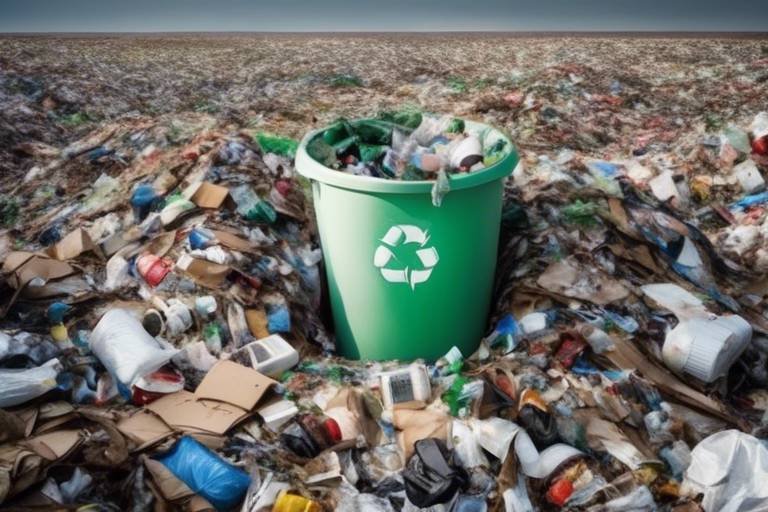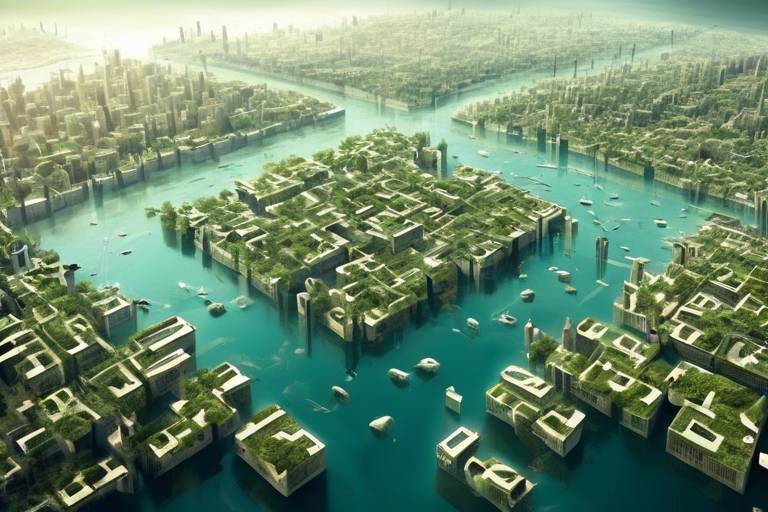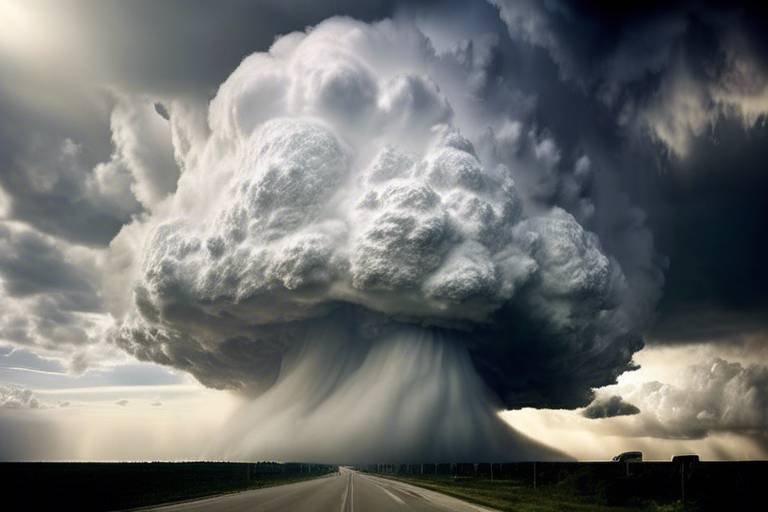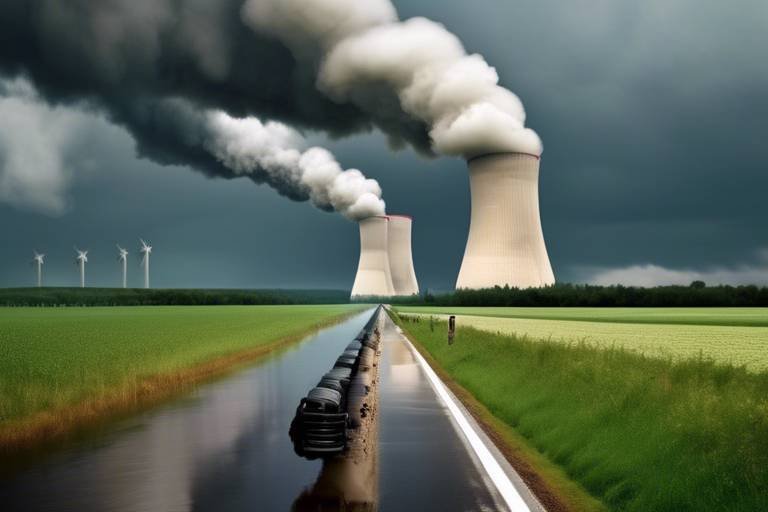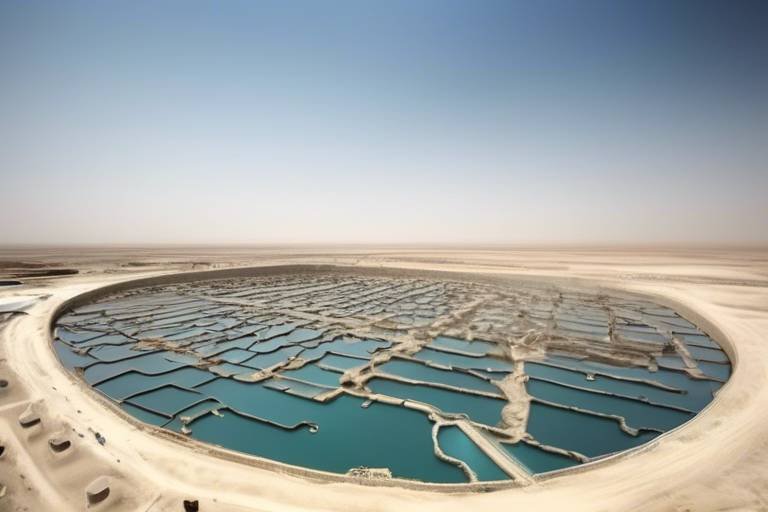Are We Doing Enough to Stop Global Warming?
Climate change is no longer a distant threat; it’s a reality that we are facing right now. With rising temperatures, melting ice caps, and increasingly severe weather events, the question looms large: The short answer is a resounding No. While there are numerous efforts underway to combat this crisis, the pace and scale of these actions often fall short of what is necessary. In this article, we will delve into the current efforts and challenges in combating global warming, examining various strategies, policies, and individual actions that are essential for effective climate change mitigation.
To grasp the gravity of the situation, we must first understand the science behind global warming. The greenhouse effect, a natural phenomenon, is exacerbated by human activities that release excessive amounts of greenhouse gases into the atmosphere. These gases trap heat, leading to rising global temperatures. As we continue to burn fossil fuels, deforest our planet, and engage in unsustainable agricultural practices, we are accelerating climate change at an alarming rate.
Now, let’s take a look at the global initiatives that are in place to tackle this issue. Numerous international agreements, like the Paris Agreement, aim to unite countries in the fight against climate change. However, the effectiveness of these agreements often hinges on the commitment of individual nations to meet their targets. While some countries have made significant strides, others lag behind, raising questions about the overall impact of these initiatives on global warming mitigation efforts.
When we zoom in on national policies and regulations, it becomes evident that the approach varies widely from country to country. Some nations have adopted ambitious climate action plans, while others prioritize economic growth over environmental sustainability. For instance, countries like Sweden and Denmark are leading the charge with robust renewable energy policies, while others still rely heavily on coal and other fossil fuels. This inconsistency can create a ripple effect, undermining global efforts to combat climate change.
Transitioning to renewable energy sources is not just essential; it's a lifeline for our planet. The progress made in adopting solar, wind, and other sustainable energy solutions is promising, yet challenges remain. Investment in infrastructure, technological innovation, and public acceptance are crucial for accelerating this transition. The table below highlights the renewable energy adoption rates in various countries:
| Country | Renewable Energy Share (%) | Year |
|---|---|---|
| Germany | 42 | 2020 |
| China | 28 | 2020 |
| United States | 20 | 2020 |
| India | 24 | 2020 |
Carbon pricing mechanisms are another strategy gaining traction worldwide. By putting a price on carbon emissions, governments can incentivize businesses to reduce their carbon footprint. This approach can take various forms, including carbon taxes and cap-and-trade systems. While some regions have successfully implemented these strategies, others face significant political and economic hurdles.
Grassroots movements are vital in the fight against climate change. Local initiatives often inspire broader action and demonstrate that change can begin at the community level. From community gardens to local renewable energy projects, the potential for impact is immense. How can communities contribute effectively? By organizing, educating, and advocating for sustainable practices, individuals can drive significant change.
Technological advancements play a crucial role in addressing climate change. Innovations such as carbon capture, electric vehicles, and smart grids are paving the way for a more sustainable future. These technologies can significantly reduce emissions, but widespread adoption is essential for their effectiveness.
Education is a powerful tool in the fight against climate change. Awareness campaigns and educational programs can drive societal change by informing the public about the urgency of the issue. When individuals understand the impact of their actions, they are more likely to make sustainable choices.
Lastly, we must recognize that every individual has a role to play in combating global warming. Simple actions, like reducing energy consumption, using public transport, and supporting sustainable products, can collectively make a significant difference. By taking personal responsibility, we can contribute to a more sustainable future for our planet.
- What is global warming? Global warming refers to the long-term increase in Earth's average surface temperature due to human activities, primarily the burning of fossil fuels.
- What can I do to help stop global warming? You can reduce your carbon footprint by using energy-efficient appliances, minimizing car travel, and supporting renewable energy sources.
- Are governments doing enough to combat climate change? While some governments are making progress, many still fall short of the necessary actions to meet climate targets.

The Science of Global Warming
Understanding the scientific principles behind global warming is crucial to grasping the urgency of the climate crisis we face today. At its core, global warming refers to the gradual increase in the Earth's average surface temperature due to the accumulation of greenhouse gases in the atmosphere. These gases, such as carbon dioxide (CO2), methane (CH4), and nitrous oxide (N2O), trap heat from the sun, creating a greenhouse effect. Imagine the Earth as a giant greenhouse; just as a greenhouse retains heat to foster plant growth, our atmosphere retains heat to maintain life. However, the excess greenhouse gases produced by human activities are like adding more glass to that greenhouse—eventually, it becomes too hot.
The rise in global temperatures has profound implications. According to the Intergovernmental Panel on Climate Change (IPCC), the Earth's average temperature has already increased by approximately 1.1 degrees Celsius since the late 19th century. This might not sound like much, but it’s enough to trigger extreme weather events, rising sea levels, and devastating impacts on ecosystems. For instance, the melting of polar ice caps and glaciers contributes to rising sea levels, which threaten coastal communities worldwide. Without immediate action, scientists warn that we could see a temperature rise of 1.5 degrees Celsius as early as 2030, leading to catastrophic consequences.
So, what causes these greenhouse gas emissions? The primary culprits include:
- Fossil Fuel Combustion: The burning of coal, oil, and natural gas for energy is the largest source of global CO2 emissions.
- Deforestation: Trees absorb CO2, so when forests are cut down, not only is this carbon sink lost, but the carbon stored in trees is released back into the atmosphere.
- Agricultural Practices: Livestock production generates significant methane emissions, while certain fertilizers release nitrous oxide.
Understanding these factors is essential for developing effective strategies to combat global warming. Scientists are continually researching ways to reduce these emissions and mitigate their impact. For example, advancements in renewable energy technologies, such as solar and wind power, offer promising alternatives to fossil fuels. However, transitioning to these sustainable options requires not just technological innovation but also a shift in societal attitudes and policies.
Moreover, the role of feedback loops in climate change cannot be overlooked. For instance, as polar ice melts, less sunlight is reflected back into space, leading to further warming and even more ice melt—a vicious cycle that accelerates the problem. This is where the science of global warming becomes particularly alarming; the more we learn, the clearer it becomes that immediate action is necessary to break these cycles and ensure a stable climate for future generations.
In summary, the science of global warming is a complex interplay of natural processes and human activities. It highlights the urgent need for comprehensive strategies that encompass technological innovation, policy reform, and individual responsibility. By understanding the science, we can better appreciate the gravity of the situation and the steps we need to take to reverse the trend of climate change.
Q: What are greenhouse gases?
A: Greenhouse gases are gases in the Earth's atmosphere that trap heat, including carbon dioxide, methane, and nitrous oxide.
Q: How does global warming affect the environment?
A: Global warming leads to rising sea levels, extreme weather events, and disruptions to ecosystems, threatening biodiversity.
Q: What can individuals do to combat global warming?
A: Individuals can reduce their carbon footprint by using public transport, conserving energy at home, and supporting renewable energy initiatives.

Current Global Initiatives
In the battle against global warming, numerous global initiatives have emerged, aiming to unite nations in a common cause. One of the most significant milestones in this fight is the Paris Agreement, adopted in 2015. This landmark accord brought together almost every country on the planet with a shared commitment to limit global temperature rise to well below 2 degrees Celsius above pre-industrial levels. But what does this really mean for us? It signifies a collective recognition that we must take drastic action to curb greenhouse gas emissions and transition to a more sustainable future.
However, the Paris Agreement is just the tip of the iceberg. Various international frameworks and agreements have been established to guide countries in their climate actions. For example, the United Nations Framework Convention on Climate Change (UNFCCC) plays a pivotal role in coordinating global efforts. Through annual conferences known as the Conference of the Parties (COP), nations gather to assess progress and set new targets. These gatherings are crucial, as they provide a platform for countries to share their successes and challenges, fostering collaboration and innovation.
But it’s not just about treaties and agreements. There are also initiatives focused on specific sectors, such as the Global Methane Pledge, which aims to reduce methane emissions by 30% by 2030. Methane, a potent greenhouse gas, is responsible for a significant portion of global warming. By targeting this gas, countries can make a substantial impact in a relatively short time frame. Additionally, the Carbon Neutrality Coalition encourages businesses and governments to commit to achieving net-zero emissions by 2050, further emphasizing the need for accountability and action.
To gauge the effectiveness of these initiatives, it's essential to monitor progress through transparent reporting mechanisms. Countries are required to submit their Nationally Determined Contributions (NDCs), which outline their plans for reducing emissions. This system not only holds nations accountable but also allows for the sharing of best practices and innovative solutions. For instance, countries like Norway and Germany have been recognized for their ambitious targets and impressive advancements in renewable energy technologies.
| Country | Target Year | Emission Reduction Goal |
|---|---|---|
| Norway | 2030 | 40% below 1990 levels |
| Germany | 2045 | Climate neutrality |
| United States | 2030 | 50-52% below 2005 levels |
While these initiatives are promising, the road ahead is fraught with challenges. The disparity in resources and capabilities among developed and developing nations often leads to tensions in negotiations. Wealthier countries are urged to provide financial and technological support to help developing nations transition to greener practices. This is not just an ethical obligation; it’s a necessity for global success. After all, climate change knows no borders, and its effects are felt universally.
In conclusion, the current global initiatives represent a collective effort to combat global warming, but they require unwavering commitment and collaboration. As we move forward, it’s imperative for countries to not only set ambitious goals but also to take tangible actions that lead to real change. The clock is ticking, and the future of our planet hinges on the decisions we make today.

National Policies and Regulations
When it comes to tackling the colossal challenge of global warming, play a pivotal role. Each country has its own unique approach, shaped by local circumstances, economic realities, and political will. But are these efforts enough to make a significant dent in the fight against climate change? The answer is complex and often nuanced.
Many nations have adopted ambitious targets aimed at reducing greenhouse gas emissions, often aligning their goals with international agreements such as the Paris Agreement. For instance, countries in the European Union have set a collective target to become climate-neutral by 2050. This means that they aim to reduce emissions to a point where they are balanced by the amount of greenhouse gases removed from the atmosphere. However, achieving such goals requires not just commitment but also effective implementation of policies.
To assess the effectiveness of these policies, we can look at various measures that governments have implemented:
- Emissions Trading Systems (ETS): These market-based approaches allow companies to buy and sell emission allowances, creating a financial incentive to lower emissions.
- Renewable Energy Standards: Many countries mandate that a certain percentage of energy must come from renewable sources, driving investment in technologies like wind and solar.
- Fuel Economy Standards: Regulations that require automakers to improve the fuel efficiency of their vehicles can significantly reduce emissions from one of the largest sources of carbon dioxide.
However, the effectiveness of these national policies can vary widely. Some countries are making remarkable strides, while others lag behind. For example, nations like Sweden and Denmark have made significant progress in reducing emissions through robust policies and public support for renewable energy. In contrast, other countries may struggle due to economic dependencies on fossil fuels or political resistance to climate action.
One of the key challenges is ensuring that national policies are not just well-intentioned but also backed by enforceable regulations and adequate funding. Without proper enforcement, even the best-designed policies can become mere words on paper. Additionally, the transition to a low-carbon economy often requires substantial investment in infrastructure, technology, and workforce training, which can be a hurdle for many governments.
To further complicate matters, the interplay between national policies and global markets can lead to unintended consequences. For instance, if one country enacts strict emissions regulations while others do not, there is a risk that businesses may relocate to less regulated regions, a phenomenon known as "carbon leakage." This not only undermines local efforts but can also lead to an overall increase in global emissions.
In light of these challenges, it’s crucial for nations to collaborate and share best practices. International cooperation can amplify the impact of national policies, ensuring that efforts to combat climate change are not isolated but part of a larger global strategy. For example, technology transfer between developed and developing nations can help accelerate the adoption of sustainable practices worldwide.
Ultimately, while national policies and regulations are essential tools in the fight against global warming, their success hinges on a combination of ambition, enforcement, and international collaboration. As we move forward, it’s imperative that we not only set ambitious targets but also create pathways to achieve them, ensuring that our actions today lead to a sustainable tomorrow.
- What are national policies on climate change? National policies on climate change refer to the laws and regulations that governments implement to reduce greenhouse gas emissions and promote sustainable practices.
- How do these policies affect global warming? Effective national policies can significantly reduce emissions, helping to mitigate the impacts of global warming by limiting the amount of greenhouse gases released into the atmosphere.
- Are all countries taking action against climate change? While many countries have made commitments to combat climate change, the level of action and effectiveness varies widely, with some countries making more progress than others.

Renewable Energy Adoption
Transitioning to renewable energy sources is not just a trend; it's a necessity for our planet's future. As we face the harsh realities of climate change, the urgency to shift from fossil fuels to cleaner energy alternatives has never been more pronounced. Imagine a world where the energy we use comes from the sun, wind, and water—sources that are abundant and sustainable. This is not a distant dream but a reality that many countries are striving to achieve.
One of the most significant advantages of renewable energy is its potential to drastically reduce greenhouse gas emissions. According to recent studies, transitioning to renewables could cut global carbon emissions by up to 70% by 2050. This is a staggering figure that highlights the power of clean energy. However, the journey to widespread adoption is fraught with challenges. These include technological limitations, high initial costs, and the need for substantial infrastructure changes. For instance, while solar panels have become more affordable, the installation process can still be a barrier for many homeowners.
Countries around the world are at different stages in their renewable energy journey. Some have embraced aggressive policies to promote solar and wind energy, while others lag behind, stuck in the traditional energy mindset. For example, countries like Denmark and Germany are leading the charge with ambitious targets to generate a significant portion of their energy from renewables. In contrast, nations heavily reliant on oil and gas face an uphill battle in shifting public perception and political will towards sustainable energy solutions.
To illustrate the current landscape of renewable energy adoption globally, consider the following table:
| Country | Renewable Energy Share (%) | Main Sources |
|---|---|---|
| Denmark | 47 | Wind, Solar |
| Germany | 42 | Solar, Wind |
| United States | 20 | Wind, Solar, Hydropower |
| China | 29 | Solar, Wind, Hydropower |
The table above highlights how different countries are harnessing renewable energy, showcasing the varying levels of commitment and success. It's clear that while some nations are making impressive strides, others have a long way to go. But why should you, as an individual, care about these statistics? The answer is simple: the more we embrace renewable energy, the less we rely on fossil fuels, which are not only limited but also contribute significantly to global warming.
Another aspect worth mentioning is the role of government incentives in promoting renewable energy adoption. Many governments offer tax breaks, subsidies, and grants to encourage households and businesses to switch to renewable energy sources. These incentives can significantly reduce the upfront costs associated with solar panel installation or wind turbine setup, making clean energy more accessible to the average consumer. However, the effectiveness of these programs often depends on public awareness and education about the benefits of renewable energy.
In conclusion, the adoption of renewable energy is a critical component in the fight against global warming. While the challenges are significant, the potential benefits are even greater. By investing in renewable energy, we can create a more sustainable future for ourselves and future generations. It's time to ask ourselves: Are we ready to make the switch and embrace the energy of the future?
- What are the main types of renewable energy? The most common types include solar, wind, hydroelectric, geothermal, and biomass energy.
- How does renewable energy help combat climate change? Renewable energy reduces reliance on fossil fuels, which are the primary source of greenhouse gas emissions contributing to global warming.
- What are the challenges of renewable energy adoption? Key challenges include high initial costs, technological limitations, and the need for better infrastructure.
- Can individuals contribute to renewable energy adoption? Absolutely! Individuals can install solar panels, support renewable energy initiatives, and advocate for clean energy policies.

Carbon Pricing Mechanisms
Carbon pricing mechanisms are essential tools in the global fight against climate change. They aim to hold businesses and individuals accountable for their greenhouse gas emissions by assigning a cost to carbon pollution. This approach creates a financial incentive to reduce emissions, encouraging a shift towards cleaner energy sources. Essentially, it’s like putting a price tag on pollution, making it clear that the environment has a cost, and we all need to pay attention to it.
There are two primary types of carbon pricing mechanisms: carbon taxes and cap-and-trade systems. Each has its unique structure and approach, but both serve the ultimate goal of reducing carbon emissions. A carbon tax directly sets a price on carbon by levying a fee on fossil fuels, which increases the cost of using coal, oil, and natural gas. This tax encourages businesses and consumers to seek alternatives, such as renewable energy sources, to avoid paying higher costs.
On the other hand, cap-and-trade systems establish a limit, or cap, on total greenhouse gas emissions from certain sectors. Governments allocate a limited number of emissions allowances, which companies can buy and sell. This market-driven approach allows businesses that can reduce emissions at a lower cost to sell their excess allowances to those facing higher costs. It’s a bit like a game of trading cards, where the goal is to keep the total emissions under control while allowing flexibility in how companies achieve that goal.
| Mechanism | Description | Pros | Cons |
|---|---|---|---|
| Carbon Tax | A direct tax on carbon emissions. |
|
|
| Cap-and-Trade | A limit on emissions with tradable allowances. |
|
|
Implementing carbon pricing mechanisms is not without its challenges. For instance, the effectiveness of these systems can be undermined by loopholes and the allocation of allowances, which may favor larger corporations over smaller entities. Furthermore, there’s often public resistance to such measures, as they can lead to higher energy costs for consumers. However, the potential benefits—like reducing overall emissions and fostering a transition to a sustainable economy—are significant and cannot be overlooked.
In conclusion, carbon pricing mechanisms represent a crucial step toward addressing global warming. By putting a price on carbon, we can motivate individuals and companies to make more environmentally friendly choices. It’s not just about the money; it’s about creating a culture of accountability and responsibility towards our planet. As we move forward, it’s essential that we continue to refine these mechanisms and ensure they work effectively for everyone involved.
Q: What is carbon pricing?
A: Carbon pricing is a method to encourage the reduction of greenhouse gas emissions by assigning a cost to carbon pollution.
Q: How does a carbon tax work?
A: A carbon tax imposes a fee on fossil fuels based on their carbon content, incentivizing businesses and consumers to reduce their carbon footprint.
Q: What is cap-and-trade?
A: Cap-and-trade is a system that sets a limit on emissions and allows companies to buy and sell allowances for their emissions, promoting cost-effective reductions.
Q: Why are carbon pricing mechanisms important?
A: They help to internalize the environmental costs of carbon emissions, encouraging innovation and investment in cleaner technologies.

Community and Local Actions
When it comes to tackling the colossal challenge of global warming, the power of cannot be underestimated. Think about it: while global policies and international treaties are essential, the real change often begins at the grassroots level. Communities around the world are stepping up, showing that local initiatives can lead to significant reductions in carbon footprints. It’s like planting a tree; each small effort contributes to a larger canopy of change.
One of the most inspiring aspects of community action is the sense of collective responsibility. When individuals come together, they can create a ripple effect that extends far beyond their immediate surroundings. For instance, local clean-up drives not only beautify neighborhoods but also raise awareness about the importance of reducing waste. Imagine a community where everyone participates in recycling programs, or where local farmers markets thrive, promoting sustainable agriculture. These actions not only combat climate change but also foster a stronger sense of community.
Moreover, community-led initiatives often focus on education and awareness. Local workshops and seminars can empower residents with knowledge about sustainable practices. For example, a neighborhood might organize a series of events to teach residents about energy efficiency in their homes, demonstrating how simple changes—like switching to LED bulbs or improving insulation—can lead to substantial energy savings. This is crucial because informed citizens are more likely to make environmentally friendly choices.
Another exciting avenue for local action is the rise of community gardens. These vibrant spaces not only provide fresh produce but also serve as a hub for education on sustainable practices. By cultivating food locally, communities can reduce their reliance on industrial agriculture, which is a significant contributor to greenhouse gas emissions. Community gardens also promote biodiversity and create green spaces that enhance urban environments.
Additionally, local governments can play a pivotal role by implementing policies that support community initiatives. For example, cities can offer grants for renewable energy projects or provide resources for local sustainability programs. When local authorities collaborate with community organizations, the impact can be profound. It’s like a well-orchestrated symphony where every instrument plays a vital role in creating harmonious change.
However, it’s essential to recognize that challenges exist. Not all communities have the same resources or access to information. To bridge this gap, successful communities can share their experiences, creating a network of support and knowledge exchange. This could take the form of online platforms or local meet-ups where ideas and strategies can be discussed and refined.
In conclusion, while global efforts are crucial in the fight against climate change, the actions taken within our communities are equally important. By fostering local initiatives, educating residents, and encouraging participation, we can create a powerful movement towards sustainability. Every small action counts, and together, we can make a significant impact in the battle against global warming.
- What are some examples of community actions against global warming?
Community gardens, local recycling programs, and educational workshops are just a few examples. - How can I get involved in my local community's climate initiatives?
Start by attending local meetings, volunteering for environmental organizations, or participating in community clean-up days. - Are local actions effective in combating climate change?
Yes, local actions can lead to significant reductions in carbon footprints and inspire broader societal change.

The Role of Technology
In our modern world, technology is not just a tool; it’s a lifeline in the fight against global warming. Think of it as our superhero cape in the battle against climate change. With every new innovation, we get a little closer to turning the tide on this pressing issue. From electric vehicles that reduce our reliance on fossil fuels to advanced carbon capture technologies that literally pull CO2 out of the air, the role of technology is pivotal. But how do these innovations work, and what impact are they really having?
One of the most exciting advancements is in the field of renewable energy. Solar panels and wind turbines have become household names, and for good reason. They harness natural resources, turning sunlight and wind into clean, sustainable energy. According to recent statistics, renewable energy accounted for over 29% of global electricity generation in 2020, and this number is only expected to grow. This shift not only helps reduce greenhouse gas emissions but also decreases our dependence on non-renewable energy sources, which are major contributors to global warming.
Another groundbreaking technology is carbon capture and storage (CCS). Imagine a giant vacuum cleaner that sucks up carbon dioxide emissions from power plants and industrial sites before they can enter the atmosphere. This technology has the potential to capture up to 90% of CO2 emissions, making it a crucial player in our climate strategy. CCS is still in its infancy, but with continued investment and innovation, it could become a game changer in our efforts to mitigate climate change.
Moreover, the rise of smart grids is revolutionizing how we consume energy. These advanced electrical grids use digital technology to monitor and manage the transport of electricity from all generation sources to meet the varying electricity demands of end users. By optimizing energy distribution, smart grids help reduce waste and improve the efficiency of energy use. This means less energy is wasted and fewer emissions are produced, creating a win-win scenario for both consumers and the environment.
But it’s not just about large-scale technologies; individual innovations also play a significant role. For instance, electric vehicles (EVs) are becoming increasingly popular as people seek more sustainable transportation options. With advancements in battery technology, EVs are now more affordable and have longer ranges than ever before. The shift to electric vehicles could potentially reduce greenhouse gas emissions from the transportation sector by over 50% by 2030, according to various studies.
In addition to these technologies, we must not overlook the importance of education and awareness. Technology alone cannot solve the problem. We need to educate individuals and communities about how to use these technologies effectively. Awareness campaigns can empower people to make informed decisions about their energy consumption and encourage them to adopt sustainable practices in their daily lives.
So, while technology is a powerful ally in the fight against global warming, it is essential that we embrace it fully and integrate it into our everyday lives. The combination of innovative solutions, public awareness, and individual responsibility can create a robust framework for combating climate change. The future is bright, and with the right tools and mindset, we can pave the way for a more sustainable planet.
- What is carbon capture and storage (CCS)? CCS is a technology that captures carbon dioxide emissions produced from the use of fossil fuels in electricity generation and stores it underground to prevent it from entering the atmosphere.
- How do electric vehicles contribute to reducing global warming? Electric vehicles produce zero tailpipe emissions and, when charged with renewable energy, can significantly lower overall greenhouse gas emissions compared to traditional gasoline-powered vehicles.
- What is a smart grid? A smart grid uses digital technology to monitor and manage the transport of electricity, improving efficiency and reducing energy waste.
- How can individuals contribute to combating global warming? Individuals can reduce their carbon footprint by using energy-efficient appliances, adopting renewable energy solutions, and choosing sustainable transportation options.

Climate Change Education
When it comes to tackling the colossal challenge of global warming, education is our secret weapon. Imagine trying to navigate a dense forest without a map; that’s what it feels like for many when faced with the complexities of climate change. This is why is not just important; it’s absolutely essential. By equipping individuals with knowledge about the causes and effects of climate change, we can empower them to take meaningful action in their own lives and communities.
Education serves as the foundation for understanding how our daily choices impact the planet. It’s not just about knowing what global warming is; it’s about grasping the interconnectedness of our actions. For instance, did you know that the average car emits about 4.6 metric tons of carbon dioxide per year? When individuals understand these statistics, it becomes easier to make conscious decisions, such as opting for public transportation or carpooling. The more people learn, the more they can contribute to reducing their carbon footprints.
Moreover, educational initiatives can inspire grassroots movements. Schools, community centers, and local organizations often host workshops and campaigns that engage people of all ages. These initiatives not only raise awareness but also foster a sense of community. When individuals come together to learn about sustainability practices, they often feel more motivated to implement changes in their own lives. For example, community gardening projects can teach participants about local food production, reducing reliance on carbon-heavy imports.
It's also crucial to consider the role of technology in climate change education. Online platforms and social media have transformed the way information is disseminated. Educational resources are now more accessible than ever, allowing people from various backgrounds to engage with climate science. Websites, webinars, and social media campaigns are powerful tools for spreading awareness and encouraging action. However, while the internet can be a treasure trove of information, it can also be a source of misinformation. This is why teaching individuals how to critically evaluate sources is a vital component of climate change education.
In schools, incorporating climate change topics into the curriculum can make a significant difference. Subjects like science, geography, and even art can be used to explore environmental issues. By integrating these themes, educators can create a holistic understanding of climate change that resonates with students. For instance, a science class could involve experiments on renewable energy sources, while an art class could focus on creating awareness posters. This interdisciplinary approach not only makes learning more engaging but also emphasizes the importance of collaboration in solving global problems.
So, what can you do to promote climate change education in your community? Here are a few suggestions:
- Volunteer at local schools or community centers to help organize educational workshops.
- Share informative articles and resources on social media to spread awareness.
- Encourage local leaders to incorporate climate education into public programs.
In conclusion, climate change education is a powerful tool for driving societal change. It fosters understanding, inspires action, and equips individuals with the knowledge needed to make a difference. By investing in education, we are not just preparing ourselves for the challenges ahead; we are also paving the way for future generations to thrive in a sustainable world.
Q: Why is climate change education important?
A: It empowers individuals with knowledge to make informed decisions, fosters community action, and helps combat misinformation.
Q: How can I get involved in climate change education?
A: You can volunteer, share resources online, or advocate for climate education in schools and community programs.
Q: What are some effective methods for teaching about climate change?
A: Incorporating hands-on activities, interdisciplinary approaches, and leveraging technology are all effective methods.

Individual Responsibility
When it comes to combating global warming, it’s easy to feel overwhelmed by the scale of the problem. However, each one of us has the power to make a significant impact through our daily choices and actions. Think of it like a giant puzzle; every small piece contributes to the bigger picture of a sustainable future. By embracing our , we can collectively drive change and inspire others to follow suit.
One of the most effective ways to reduce your carbon footprint is by making conscious decisions in your everyday life. For instance, consider your transportation habits. Opting for public transport, biking, or walking instead of driving can drastically lower greenhouse gas emissions. If you must drive, carpooling or using an electric vehicle can also make a notable difference. Just imagine if everyone in your community decided to leave their cars at home a few days a week—what a ripple effect that would create!
Another area where individual action is crucial is in our consumption patterns. The products we buy and how we dispose of them play a significant role in climate change. By choosing to support sustainable brands and reducing single-use plastics, we can lessen the demand for harmful manufacturing processes. Additionally, adopting a more plant-based diet can significantly reduce your carbon footprint, as livestock farming is one of the largest contributors to greenhouse gas emissions. It’s about making smarter choices that align with a more sustainable lifestyle.
Moreover, it’s vital to engage in community initiatives. Volunteering for local environmental organizations or participating in clean-up drives can amplify your impact. These activities not only help the environment but also foster a sense of community and shared purpose. Just think about how powerful it is to work alongside your neighbors towards a common goal—it's like planting seeds of change that can grow into a forest of action!
To help visualize the impact of individual actions, consider the following table, which outlines various personal choices and their potential carbon savings:
| Action | Estimated Carbon Savings (per year) |
|---|---|
| Switching to a plant-based diet | 1,000 kg CO2 |
| Using public transport instead of driving | 1,200 kg CO2 |
| Reducing energy use at home | 500 kg CO2 |
| Composting organic waste | 300 kg CO2 |
In conclusion, while the challenge of global warming may seem daunting, every individual has the power to contribute to the solution. By making informed choices, advocating for sustainable practices, and inspiring others, we can create a movement that significantly reduces our collective carbon footprint. Remember, change starts with you—your actions today can lead to a brighter, greener tomorrow.
Q: What are some easy ways to reduce my carbon footprint?
A: Simple actions like using public transport, reducing meat consumption, conserving energy at home, and minimizing waste can all contribute significantly to lowering your carbon footprint.
Q: How can I get involved in my community's climate action efforts?
A: Look for local environmental organizations, participate in community clean-up events, or start a sustainability group in your neighborhood to share ideas and resources.
Q: Does recycling really make a difference?
A: Yes! Recycling helps reduce the amount of waste sent to landfills and conserves natural resources, which in turn lowers greenhouse gas emissions associated with production.
Q: What role do businesses play in combating climate change?
A: Businesses can significantly impact climate change by adopting sustainable practices, reducing waste, and supporting renewable energy initiatives. Consumer demand for eco-friendly products also drives businesses to change.
Frequently Asked Questions
- What is global warming and why is it a concern?
Global warming refers to the long-term increase in Earth's average surface temperature due to human activities, primarily the release of greenhouse gases like carbon dioxide and methane. It's a concern because it leads to severe weather changes, rising sea levels, and impacts on ecosystems, which can threaten food security, health, and biodiversity.
- How do human activities contribute to global warming?
Human activities, such as burning fossil fuels for energy, deforestation, and industrial processes, release large amounts of greenhouse gases into the atmosphere. These gases trap heat, leading to the greenhouse effect, which causes the planet to warm up and disrupts natural climate patterns.
- What are some current global initiatives to combat climate change?
Several global initiatives aim to tackle climate change, with the Paris Agreement being one of the most significant. This international treaty seeks to limit global warming to well below 2 degrees Celsius compared to pre-industrial levels by encouraging countries to set and meet their own emission reduction targets.
- How effective are national policies in addressing climate change?
National policies vary widely in their effectiveness. Some countries have implemented robust regulations that align with global goals, while others lag behind. The success of these policies often depends on political will, public support, and economic factors that influence their implementation and enforcement.
- What role does renewable energy play in reducing greenhouse gas emissions?
Renewable energy sources, like solar and wind, are crucial in reducing greenhouse gas emissions because they offer cleaner alternatives to fossil fuels. Transitioning to these sustainable energy solutions helps decrease reliance on carbon-intensive energy sources and plays a significant role in mitigating climate change.
- What are carbon pricing mechanisms, and how do they work?
Carbon pricing mechanisms, such as carbon taxes and cap-and-trade systems, are designed to incentivize businesses and individuals to reduce their carbon emissions. By putting a price on carbon, these strategies encourage investment in cleaner technologies and promote a shift towards more sustainable practices.
- How can local communities contribute to climate action?
Local communities can play a vital role in climate action through grassroots movements, promoting sustainable practices, and engaging in local initiatives. Actions like community gardens, recycling programs, and local renewable energy projects can significantly reduce carbon footprints and raise awareness about climate issues.
- What technological advancements are helping to combat climate change?
Technological innovations such as carbon capture and storage, electric vehicles, and smart grids are essential tools in the fight against climate change. These technologies help reduce emissions, improve energy efficiency, and support the transition to a low-carbon economy.
- Why is climate change education important?
Education about climate change is crucial for fostering public awareness and encouraging action. By informing individuals about the causes and impacts of climate change, educational programs can empower them to make informed choices and advocate for sustainable practices in their communities.
- What can individuals do to help reduce global warming?
Individuals can make a difference by adopting sustainable practices such as reducing energy consumption, using public transport, recycling, and supporting renewable energy initiatives. Every small action counts and can contribute to a collective effort in combating climate change.







